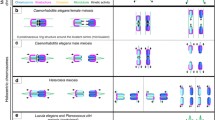Abstract
The ultrastructure of early cleavage divisions of the paedogenetic gall midge Heteropeza pygmaea (syn. Oligarces paradoxus) was analysed at different division stages determined by previous in vivo observation. The spindles are enclosed by a continuous layer of vesicles. Centrioles are absent. During anaphase the disassembling microtubules connected with normally segregating chromosomes become increasingly coated with electron-opaque material. The microtubules of eliminated chromosomes blocked in the interzone persist throughout anaphase and remain uncoated. During anaphase the spindles are considerably stretched and stem bodies are formed. The microtubules of the stem bodies are also associated with electronopaque material. These phenomena seem to be consistent with the explanation of chromosome segregation by cyclic assembly and disassembly of spindle microtubules.
Similar content being viewed by others
References
Bärlocher, F.: Beobachtung von Furchungsteilungen mit Chromosomen-Elimination in lebenden Embryonen der Gallmücke Heteropeza pygmaea. Experientia (Basel) 27, 985–987 (1971)
Bajer, A. S.: Interaction of microtubules and the mechanism of chromosome movement (zipper hypothesis). 1. General principle. Cytobios 8, 139–160 (1973)
Bajer, A. S., Molé-Bajer, J.: Spindle dynamics and chromosome movements. Int. Rev. Cytol., Suppl. 3 (1972)
Burkholder, G. D., Okada, T. A., Comings, D. E.: Whole mount electron microscopy of metaphase. I. Chromosomes and microtubules from mouse oocytes. Exp. Cell Res. 75, 497–511 (1972)
Busson-Mabillot, S.: Influence de la fixation chimique sur les ultrastructures. I. Etude sur les organites du follicule ovarien d'un poisson téléostéen. J. Microscopie 12, 317–348 (1971)
Camenzind, R.: Die Zytologie der bisexuellen und parthenogenetischen Fortpflanzung von Heteropeza pygmaea Winnertz, einer Gallmücke mit paedogenetischer Vermehrung. Chromosoma (Berl.) 18, 123–152 (1966)
Camenzind, R.: Chromosome elimination in Heteropeza pygmaea. I. In vivo observations. Chromosoma (Berl.) 49, 87–98 (1974)
Dietz, R.: Die Assembly-Hypothese der Chromosomenbewegung und die Veränderungen der Spindellänge während der Anaphase. I in Spermatocyten von Pales ferruginea (Tipulidae, Diptera). Chromosoma (Berl.) 38, 11–76 (1972)
Fahimi, H. D., Drochmans, P.: Essais de standardisation de la fixation au glutaraldéhyde. II. Influence des concentrations en aldéhyde et de l'osmolalité. J. Microscopie 4, 737–748 (1965)
Inoué, S., Sato, H.: Cell motility by labile association of molecules: The nature of the mitotic spindle fibers and their role in chromosome movement. J. gen. Physiol. 50, 259–292 (1967)
Jensen, C., Bajer, A.: Spindle dynamics and arrangement of microtubules. Chromosoma (Berl.) 44, 73–89 (1973)
Luykx, P.: Cellular mechanisms of chromosome distribution. Int. Rev. Cytol., Suppl. 2 (1970)
McIntosh, J. R., Hepler, P. K., Wie, D. G. van: Model for mitosis. Nature (Lond.) 224, 659–663 (1969)
Mollenhauer, H. H.: Plastic embedding mixtures for use in electron microscopy. Stain Technol. 39, 111–114 (1963)
Nicklas, R. B.: An experimental and descriptive study of chromosome elimination in Miaster spec. (Cecidomyidae; Diptera). Chromosoma (Berl.) 10, 301–336 (1959)
Nicklas, R. B.: Mitosis. In: Advances in cell biology, p. 225–297. New York: Appleton 1971
Reynolds, E. S.: The use of lead citrate at high pH as an electron-opaque stain in electron microscopy. J. Cell Biol. 17, 208–212 (1963)
Sitte, P.: Einfaches Verfahren zur stufenlosen Gewebe-Entwässerung für die elektronenmikroskopische Präparation. Naturwissenschaften 17, 402–403 (1962)
Stebbings, H., Willison, J. H. M.: Structure of microtubules: A study of freezeetched and negatively stained microtubules from the ovaries of Notonecta. Z. Zellforsch. 138, 387–396 (1972)
Weisenberg, R. C.: Microtubule formation in vitro in solutions containing low calcium concentrations. Science 177, 1104 (1972)
Wegner, K. W.: Easy and accurate collection of thin serial sections by means of a grid support. Mikroskopie 27, 289–293 (1971)
Went, D.: In vitro culture of eggs and embryos in the viviparous paedogenetic gall midge Heteropeza pygmaea. J. exp. Zool. 177, 301–312 (1971)
Author information
Authors and Affiliations
Rights and permissions
About this article
Cite this article
Fux, T. Chromosome elimination in Heteropeza pygmaea . Chromosoma 49, 99–112 (1974). https://doi.org/10.1007/BF00284991
Received:
Issue Date:
DOI: https://doi.org/10.1007/BF00284991




